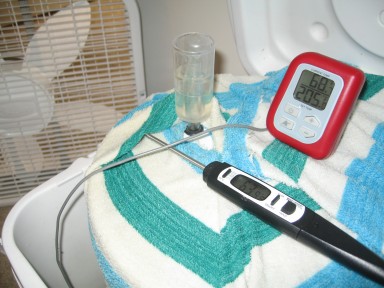I’ve had several people ask me recently about keeping fermentation temperatures down during the summer. First it’s probably necessary to detail exactly what “optimal” fermentation temperatures actually are. Every yeast strain out there has a published optimum temperature range; the data are available directly from White Labs and WYeast, as well as at most homebrew shops. In general, the lower end of the temperature range is fairly optimal and the upper end is far too high. (The exceptions to this rule are Belgian yeast strains, which may be ramped from a “normal” ale fermentation temperature to 25°C (77°F) or more over a period of a few days, in order to accentuate their ester profiles.)
That said, the vast majority of ale fermentations should take place in the range 15-21°C (59-70°F). For lagers, the range is somewhat narrower; about 8-11°C (46-52°F). It’s important to recognize that these are the temperatures of the beer itself; a vigorous fermentation can be several degrees above the ambient temperature. The key, then, to getting reliable results from fermentation is to start at or slightly below the desired temperature and apply sufficient cooling to keep it there. The most reliable way to do that is to use a thermostat to control a refrigerator or freezer, and simply place the fermenter inside. In my opinion, though, the up-front costs aren’t really justified unless you already have a spare refrigerator or freezer. If you have a kegerator, however, good news: serving temps overlap lager fermentation temps pretty nicely. If you don’t have a kegerator or can’t spare the room in it, though, there are still some simple options.
What I like to do is place the fermenter in a cooler (which also happens to be my mash tun) partially filled with tap water. The water temperature will remain a degree or two lower than the air temperature due to evaporation. If that isn’t enough cooling, a towel or t-shirt wrapped around the fermenter and dangled below the waterline will wick moisture further up the fermenter and reduce the temperature another degree or two. A fan blowing across the system helps even more. Finally, if the temperature drop still isn’t large enough, as in the case of a lager, cold packs or frozen water bottles can be dumped in the water and rotated every few hours. By doing this I’ve conducted lager fermentations when ambient temps are well above 80°F.
In the image below a wet towel and fan are being used without any ice. As you can see, the temperature of the water is about 69°F and the top of the towel is about 64°F, nicely bracketing the desired temperature for an ale. The ambient temperature was 73°F.


Hi Sean,
I too struggle with regulating fermentation temps during the summer and recently tried improving on the swamp cooling method. Instead of covering the carboy in a cotton t-shirt I substituted an old runners shirt made from wicking fabric (like CoolMax). The fabric seems to evaporate the water quicker than cotton. I’m able to maintain between 68-70 degrees with the ambient air being at 77. Not bad. I’ve also thought about using some wool felt but haven’t gotten around to it yet.
Have you ever experimented with different fabrics to see what provides the best evaporation efficiency?
Cheers!
I might try that Nike Dri-fit material. I think its just polyester but it seems pull the moisture real well.
Thanks for the idea.
Stephan
Webmaster, dewaltbatteries.org
Dewalt Batteries
After reading the comments, I’m going to do some research on cloth used for humidifying equipment where easy evaporation is essential to performance.
There has to be some basic science that can be used to determine which types of material would yield the best results.
If I come up with anything, I’ll circle back.
Thanks for the idea …got me thinking
@Taylor – please do.
I am going to stop by a local brew store next time i’m over that side of town. I’ll ask and let you know what I find out as well.
The more ideas the better.
Thanks